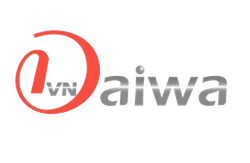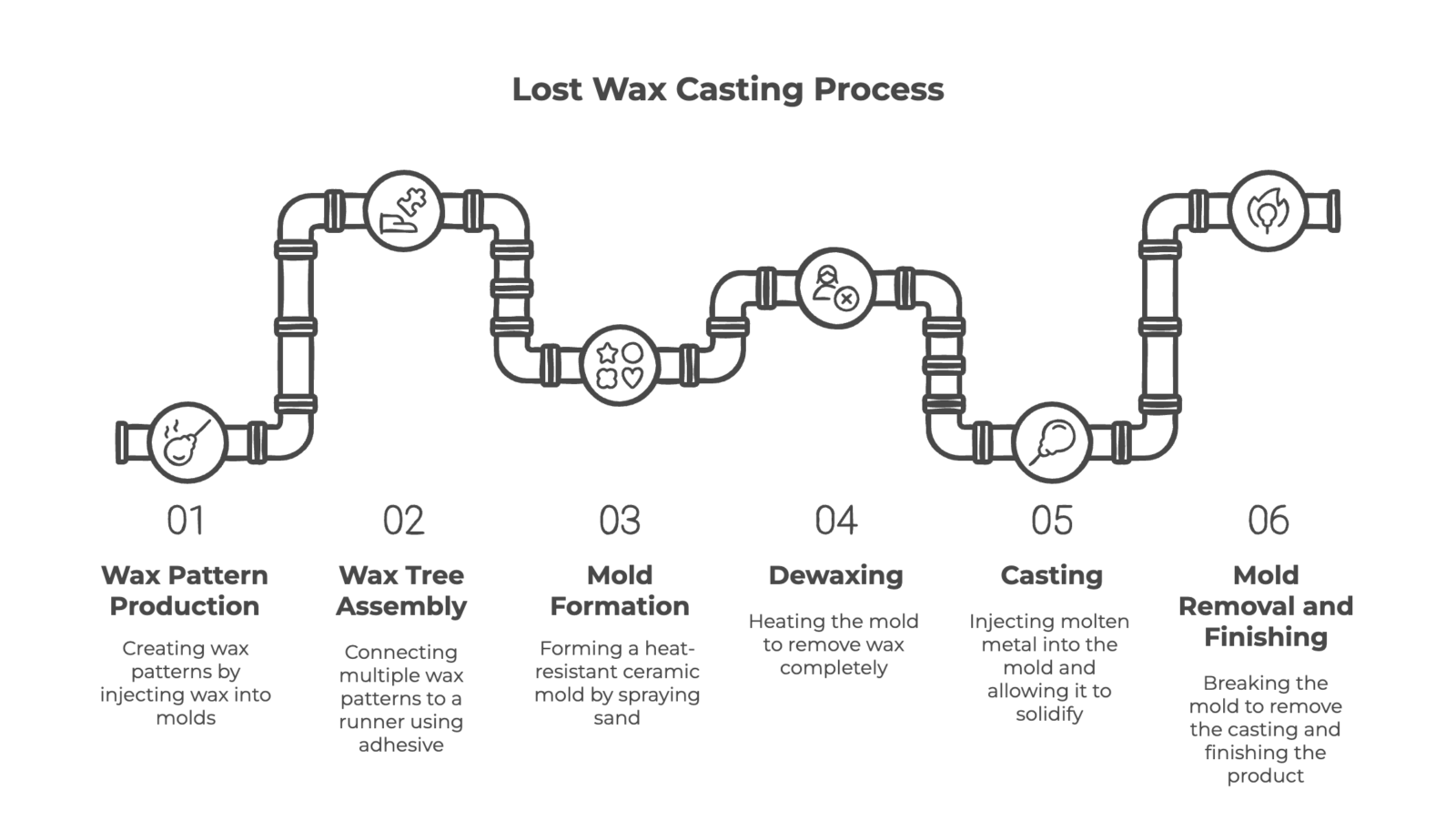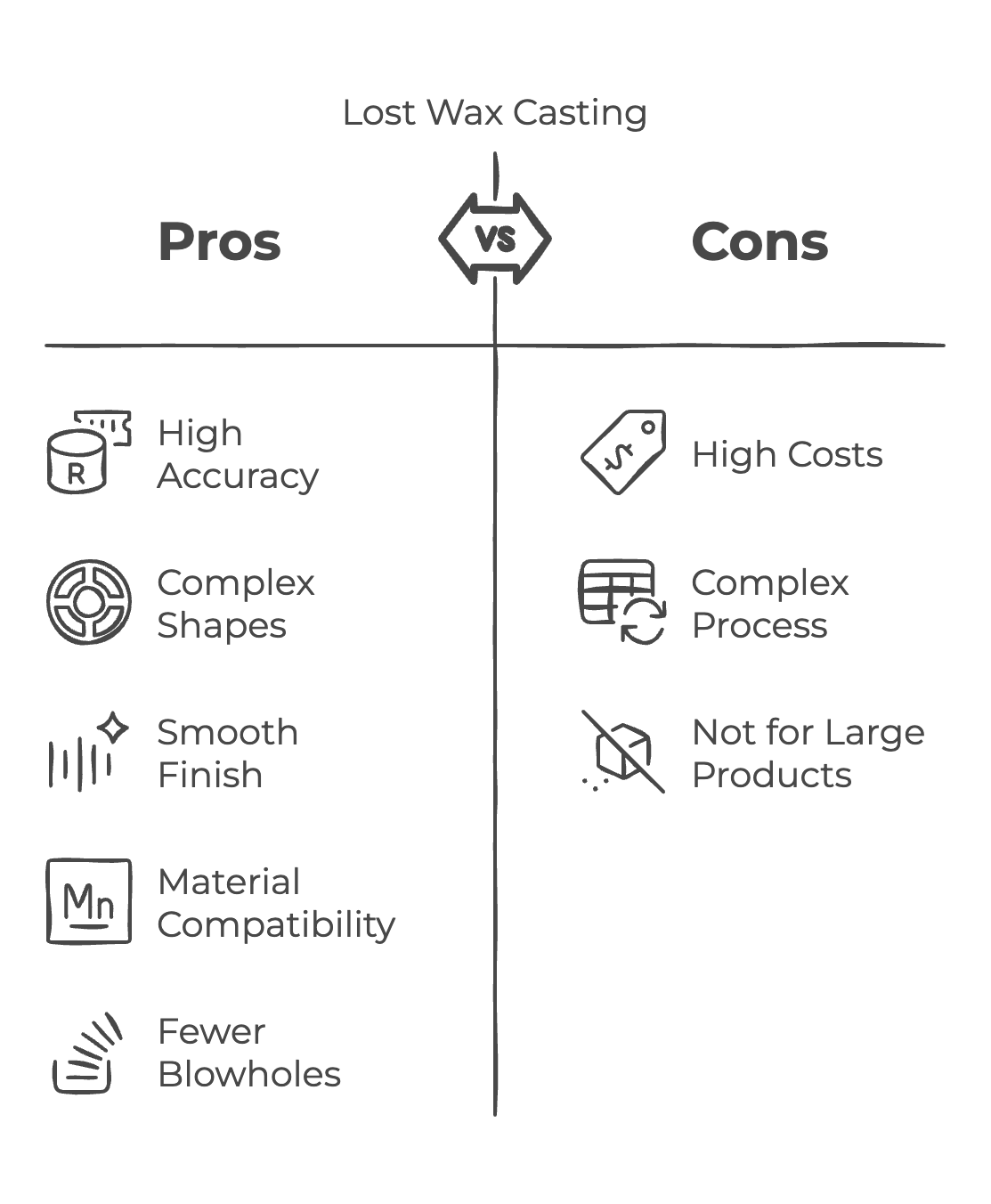◆Table of contents
ToggleIntroduction
Aluminum casting is a casting method that uses aluminum, which is lightweight and corrosion-resistant, as a material, and is used in a wide range of industries. Among them, lost wax casting is a method of manufacturing complex-shaped products with high precision by creating a precise mold using a wax pattern. It is used in fields that require high quality, such as aerospace, medical equipment, and automobile parts.
This article focuses on lost wax casting in aluminum casting, and explains its technology, advantages and disadvantages, manufacturing process, application examples, and latest trends. It provides readers with information that will help them deepen their understanding of lost wax casting and select the optimal casting method.
What is Lost Wax Casting?
Definition and Characteristics of Lost Wax Casting
Lost wax casting is a type of precision casting method, a technique suitable for manufacturing metal products with complex shapes with high accuracy. The name derives from the fact that the prototype made of wax is lost in the casting process.
The biggest feature of lost wax casting is that it can reproduce complex shapes with high accuracy. Because wax prototypes can be processed relatively easily, complex shapes and designs with attention to detail can be faithfully reproduced. In addition, since the molds are also made precisely, the dimensional accuracy of the final product is high, which can reduce the need for additional processing.
Differences from Other Casting Methods
| Casting Method | Characteristics | Advantages | Disadvantages | Differences from Lost Wax Casting |
|---|---|---|---|---|
| Sand Casting | Uses sand as a mold | Inexpensive, suitable for large products | Poor dimensional accuracy and casting skin | Not suitable for complex shapes and high precision |
| Die Casting | High-speed injection of molten metal into a metal mold | High-speed, mass production | Not suitable for complex shapes and thin-walled products | Not suitable for high precision and small-volume production |
| Metal Mold Casting | Uses a metal mold | High dimensional accuracy, mass production | High cost of mold production | Not suitable for small-volume production |
| Lost Wax Casting | Creates a mold based on a wax prototype | Complex shapes, high precision | High running costs, not suitable for mass production | Superior to other casting methods in complex shapes and high precision |
In addition to lost wax casting, there are other casting methods such as sand casting, die casting, and metal mold casting. Each casting method has its own strengths and characteristics, and lost wax casting is one of them.
Sand casting is the most common casting method that uses sand as a mold. It is relatively inexpensive and suitable for manufacturing large products, but its dimensional accuracy and casting skin are inferior to lost wax casting.
Die casting is a casting method that injects molten metal into a metal mold at high speed, suitable for high-speed and mass production. However, it is not suitable for manufacturing complex shapes and thin-walled products.
Metal mold casting is a casting method that uses a metal mold, suitable for mass production like die casting. Although the dimensional accuracy is high, mold production is costly.
Lost wax casting is superior to these casting methods in manufacturing products that require complex shapes and high precision. However, it also has the aspect that running costs are high and it is not suitable for mass production.
Cases where lost wax casting is selected
- Products with complex shapes
- Products that require high dimensional accuracy
- Small-volume production products
- Products that require a beautiful finish
If the above conditions are met, lost wax casting is the best option.
Lost Wax Casting Process
| Process | Details | Materials | Points |
|---|---|---|---|
| 1. Wax Pattern Production | Wax injection into mold, pattern creation | Wax, mold | Mold accuracy directly affects pattern accuracy |
| 2. Wax Tree Assembly | Connect multiple patterns to the runner | Wax, adhesive | Runner design, adhesive strength |
| 3. Mold Formation | Ceramic layer formation, sand spraying | Ceramic powder, binder, sand | Ceramic layer’s heat resistance, strength, air permeability |
| 4. Dewaxing | Mold heating, wax removal | – | Complete wax removal |
| 5. Casting | Molten metal injection, cooling solidification | Molten metal | Metal type, temperature, injection speed |
| 6. Mold Removal and Finishing | Mold destruction, casting removal, finishing | – | Mold destruction, finishing |
Points for Each Process
- Wax Pattern Production: It is important to use a precise mold and understand the characteristics of wax.
- Wax Tree Assembly: Runner design and adhesive selection are key points.
- Mold Formation: Ceramic layer quality and sand selection are important.
- Dewaxing: Completely remove wax and make the mold heat-resistant.
- Casting: Properly manage the type and temperature of molten metal, and injection speed.
- Mold Removal and Finishing: Destroy the mold so as not to damage the casting, and enhance accuracy and aesthetics with finishing.
Lost Wax Casting in Aluminum Casting
Application to Aluminum Casting
Aluminum alloys are used in a wide range of industries due to their light weight and excellent corrosion resistance. Although there are many types of casting methods, lost wax casting is one of the casting methods that can maximize the properties of aluminum alloys.
In particular, lost wax casting is an effective means in the following cases.
- Products with complex shapes: Products with complex shapes that are difficult to manufacture by other casting methods can be manufactured with high precision by lost wax casting.
- Products that require high dimensional accuracy: Suitable for products that require high dimensional accuracy because it uses precise molds.
- Small-volume production products: Unlike die casting, which is expensive to produce molds, it is also suitable for small-volume production products.
- Thin-walled products: Thin-walled products can also be beautifully formed by lost wax casting.
- Products that require high-quality casting skin: The casting skin is smooth and beautiful, and finishing in the post-process is easy.
Specific product examples include aircraft parts, automobile parts, medical equipment parts, and architectural ornaments.
Impact on Quality
Lost wax casting has various effects on the quality of aluminum castings.
- Dimensional accuracy: High dimensional accuracy can be achieved by using precise molds.
- Casting skin: The casting skin is smooth and beautiful, making finishing in the post-process easy.
- Blowholes: Because the mold is breathable, gas and entrained air are easily released, and blowholes are less likely to occur.
- Mechanical properties: By selecting appropriate casting conditions, castings with high mechanical properties can be manufactured.
However, lost wax casting tends to have higher running costs compared to other casting methods. Therefore, it is necessary to select the optimal casting method considering the product shape, dimensional accuracy, production volume, cost, and other factors.
Advantages and Disadvantages of Lost Wax Casting
Lost wax casting is an excellent technology that can produce precise castings, but it has not only advantages but also disadvantages. Here, we will explain in detail the advantages and disadvantages of lost wax casting and their impact on cost, delivery time, and quality.
Advantages
- High Dimensional Accuracy: Very high dimensional accuracy can be achieved by using precise molds. This reduces the need for additional processing and leads to cost reduction.
- Manufacturing of Complex Shapes: Complex shapes and thin-walled products that are difficult to manufacture by other casting methods can be manufactured with high precision by lost wax casting.
- Beautiful Casting Skin: The casting skin is smooth and beautiful, making finishing in the post-process easy.
- Compatibility with Various Materials: Compatible with various metal materials such as stainless steel, copper alloy, and titanium, as well as aluminum alloys.
- Reduction of Blowholes: Because the mold is breathable, gas and entrained air are easily released, and blowholes are less likely to occur.
Disadvantages
- High Running Costs: Running costs are high because molds are disposable. Especially unsuitable for mass production.
- Complex Process: The process is complex and requires high technical skills and experience.
- Not Suitable for Large Products: Not suitable for manufacturing large products because there are limits to the strength of the mold.
Impact on Cost, Delivery Time, and Quality
- Cost:
- Initial costs are relatively low, but running costs are high.
- Material and labor costs tend to be high due to precise molds and complex processes.
- Delivery Time:
- Delivery time may be long due to the complex process.
- Especially for prototypes and small-volume production, delivery time management is important.
- Quality:
- High-quality castings can be manufactured, such as high dimensional accuracy, beautiful casting skin, and reduction of blowholes.
- However, process control and lack of technical skills can lead to quality degradation.
Strengths of Daiwa Keikinzoku
Daiwa Keikinzoku has strengths such as cost reduction through production in Vietnam, high quality through Japanese-style management, and local procurement in Vietnam.
- Cost Reduction: Manufacturing costs can be significantly reduced by utilizing Vietnam’s low labor and material costs.
- High Quality: Thorough quality control by introducing a Japanese-style management system.
- Local Procurement: By procuring materials in Vietnam, procurement costs are reduced and the supply chain is stabilized.
Latest Technology Trends
Lost wax casting, while a traditional technology, continues to evolve. In recent years, the following latest technologies have been introduced, enabling higher quality and more efficient production.
Utilization of 3D Printers
The advent of 3D printers has brought about a major transformation in lost wax casting. Traditionally, wax patterns were made using molds, but using 3D printers can significantly reduce the cost and time of mold production.
Wax patterns made with 3D printers can express complex shapes more freely, further expanding the possibilities of lost wax casting. It is also suitable for prototypes and small-volume production, contributing to speeding up product development.
Introduction of Digital Technology
The introduction of digital technologies such as CAD/CAM has streamlined the process from design to manufacturing.
By designing wax patterns based on CAD data and manufacturing patterns with 3D printers using CAM data, high-precision molds can be created in a short time. Also, by utilizing casting simulation technology, it becomes possible to predict casting defects in advance and take countermeasures.
Environmentally Friendly Technology
In recent years, as interest in environmental issues has increased, the introduction of environmentally friendly technology in lost wax casting is also progressing.
- Use of Recyclable Materials: Promotes the reuse of mold materials and wax, contributing to waste reduction.
- Energy Saving: Reduces energy consumption by streamlining the casting process and saving energy in equipment.
- Reduction of Hazardous Substances: The development of technologies that use materials with low environmental impact and suppress the emission of hazardous substances is progressing.
With the introduction of these latest technologies, lost wax casting continues to evolve into a higher quality, more efficient, and environmentally friendly manufacturing technology.
Summary
Lost wax casting is the optimal technology for manufacturing products that require complex shapes and high precision. It is used in various fields such as aerospace, medical equipment, and automobiles, and its importance is expected to increase further in the future.
In recent years, the latest technologies related to lost wax casting, such as the use of 3D printers, the introduction of digital technology, and the development of environmentally friendly technology, have also progressed. By incorporating these technologies, more efficient and high-quality product manufacturing becomes possible.


